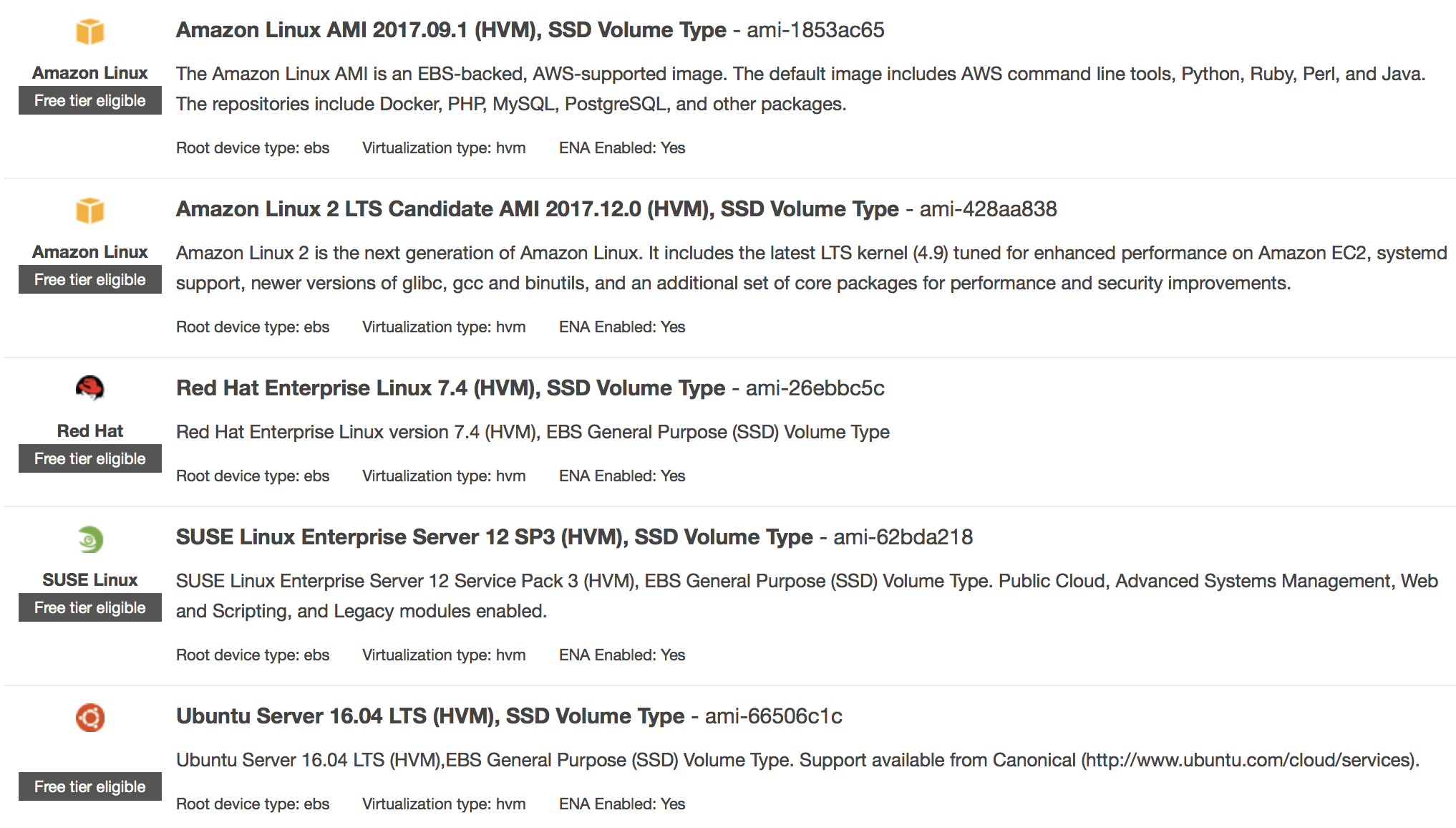Install compilers and NetCDF libraries¶
Start with a brand new system¶
Please follow AWS official tutorial to launch an EC2 instance with a branch new Linux system. The only difference from our quick start guide is in “Step 1: Choose an Amazon Machine Image (AMI)”. Instead of starting with our tutorial AMI, here you will start with a basic AMI with almost nothing installed.
AWS promotes their Amazon Linux AMI but there are many other options:

So which to choose? Recall that Linux distributions fall into two big categories:
- The Debian family, such as Debian GNU/Linux and Ubuntu. They use
aptas the high-level package manager anddpkgas the low-level one. - The Red Hat family, such as Red Hat Enterprise Linux (RHEL) and CentOS. Amazon Linux also belongs to this family. They use
yumas the high-level package manager andrpmas the low-level one.
Ubuntu tends to have the largest user base; CentOS seems to be widely used on HPC clusters; Amazon Linux has the most native AWS support. I find the model performance almost the same on different systems; but this could depend on specific programs.
In this guide, we use with Ubuntu 16.04 LTS (ami-66506c1c) as the major example. Commands for Amazon Linux 2017.09.1 (ami-1853ac65) are also provided for reference.
To test software installation, the smallest instance “t2.micro” is good enough.
Install C and Fortran compilers¶
Ubuntu¶
On Ubuntu, first update package metadata:
$ sudo apt-get update
We use the GNU compiler family which is free and open source:
$ sudo apt-get install gcc gfortran
(Alternatively, you can install Intel compilers if you have the license, or PGI compilers for CUDA Fortran and OpenACC support.)
Executables will be installed to /usr/bin/:
$ which gcc gfortran
/usr/bin/gcc
/usr/bin/gfortran
By default the package manager gets 5.4.0:
$ gcc --version
gcc (Ubuntu 5.4.0-6ubuntu1~16.04.9) 5.4.0 20160609
...
$ gfortran --version
GNU Fortran (Ubuntu 5.4.0-6ubuntu1~16.04.9) 5.4.0 20160609
...
You can also install higher versions from the Toolchain test builds, for example:
$ sudo add-apt-repository ppa:ubuntu-toolchain-r/test
Press [ENTER]
$ sudo apt-get update
$ sudo apt-get install gfortran-7
Amazon Linux¶
For Amazon Linux, the equivalent command is:
$ sudo yum install gcc gcc-gfortran
It gets 4.8.5 by default:
$ gcc --version
gcc (GCC) 4.8.5 20150623 (Red Hat 4.8.5-11)
$ gfortran --version
GNU Fortran (GCC) 4.8.5 20150623 (Red Hat 4.8.5-11)
Install NetCDF library with package manager¶
The NetCDF library is ubiquitously used in Earth science models. Getting it from the package manager is extremely easy and quick.
Ubuntu¶
On Ubuntu, simply:
$ sudo apt-get install libnetcdf-dev libnetcdff-dev
Note that “dev” stands for “development tool” since you are going to use it to compile models. (it is not “developing version” – the package repository is quite mature and stable!) Also note that after version 4.2, the NetCDF-C and NetCDF-Fortran libraries are installed separately.
Check NetCDF-C configuration:
$ nc-config --all
This netCDF 4.4.0 has been built with the following features:
...
Check NetCDF-Fortran configuration:
$ nf-config --all
This netCDF-Fortran 4.4.3 has been built with the following features:
...
--prefix -> /usr
--includedir-> /usr/include
--version -> netCDF-Fortran 4.4.3
--includedir will be used to include this NetCDF library when compiling Fortran code.
Amazon Linux¶
For Amazon Linux, NetCDF libraries are not in the default repository. You need to first enable the Extra Packages for Enterprise Linux (EPEL):
$ sudo yum-config-manager --enable epel
(See AWS guide for enabling EPEL on CentOS and Ret Hat).
Then get NetCDF from the EPEL repo:
$ sudo yum install netcdf-devel
This currently gives you 4.1.1 with C and Fortran bundled together:
$ nc-config --all
This netCDF 4.1.1 has been built with the following features:
...
(CentOS’s package registry has a newer version of NetCDF which separates Fortran and C libraries, so you would need sudo yum install -y netcdf-devel netcdf-fortran-devel)
However, this NetCDF distribution seems to lack /usr/include/netcdf.mod for use netcdf statement in Fortran 90 code. The include 'netcdf.inc' statement would work fine.
CentOS will put one at /usr/lib64/gfortran/modules/netcdf.mod. The include statement needs to be changed to -I/usr/lib64/gfortran/modules/.
Test sample NetCDF code¶
Get some sample code, such as simple_xy_wr.f90.
$ wget https://www.unidata.ucar.edu/software/netcdf/examples/programs/simple_xy_wr.f90
$ gfortran simple_xy_wr.f90 -o test_nc.exe -I/usr/include -lnetcdff
$ ./test_nc.exe
*** SUCCESS writing example file simple_xy.nc!
Install ncdump to check data content:
$ sudo apt install netcdf-bin
$ ncdump -h simple_xy.nc
netcdf simple_xy {
dimensions:
x = 6 ;
y = 12 ;
variables:
int data(x, y) ;
}
(Optional) Install NetCDF from source code¶
You might want to build NetCDF from source if:
- To install into a different directory. Package managers can only install libraries into
/usr. - To ensure the latest version. Package managers are not necessarily up-to-date.
Doing so is quite tedious so we will not cover it here. Please refer to the official guide.
For NetCDF library, you generally won’t get better performance by compiling it from source with better optimized compiler settings. That’s because NetCDF is just an I/O library, not for numerical computation. However, for other compute-oriented libraries, compiling from source can sometimes make a big difference in performance.